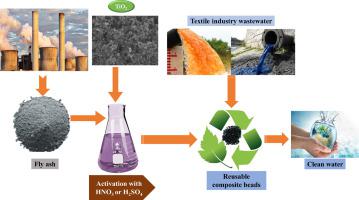Journal of Water Process Engineering ( IF 7 ) Pub Date : 2022-07-13 , DOI: 10.1016/j.jwpe.2022.102993 Rutuben Gajera , Raj Vardhan Patel , Anshul Yadav , Pawan Kumar Labhasetwar

|
This study evaluated the performance of TiO2 loaded flyash chitosan composite for the adsorption of anionic dye (congo red-CR) and catatonic dye (methylene blue-MB) dyes. Flyash was modified using HNO3 and H2SO4 to increase its surface area. The flyash and composites were characterized using morphological (scanning electron microscopy; Brunauer, Emmett and Teller surface area), spectral (Fourier-transform infrared; X-ray diffraction) and thermogravimetric techniques. The morphological analysis of the composite adsorbent revealed an irregular and rough surface, providing more adsorption sites for dye adsorption. The acid-activated adsorbents showed higher adsorption for CR than MB dye. For CR dye, the removal efficiencies were 98 %, 97 %, and 90 % for composite adsorbents MFA-1 (H2SO4 modified), MFA-2 (HNO3 modified), and UFA (raw flyash), respectively. For MB dye, the removal efficiencies were 60 %, 58 %, and 50 % for composite adsorbents MFA-1, MFA-2, and UFA, respectively. The maximum adsorption capacities of 163.51, 160.55 and 154.21 mg g−1 for MFA-1, MFA-2 and UFA, respectively, were observed for the CR dye. While for the MB dye, the maximum adsorption capacities of 55.75, 52.64 and 35.09 mg g−1 for MFA-1, MFA-2 and UFA, respectively. The improvement of dye removal on acid composites than unmodified flys ash compsitewas credited to the increased active sites due to acid modification of fly ash. The PSO kinetic model and Langmuir adsorption isotherms were the best fit for the experimental results. The incorporation of TiO2 inculcated photocatalytic regeneration ability in the composite adsorbents. This allowed the adsorbent to be utilized in several cycles without thermal or chemical treatment. This study concluded that the proposed adsorbent could be an effective solution for textile industry wastewater treatment.
中文翻译:

光催化粉煤灰/TiO2改性壳聚糖生物聚合物复合材料对阳离子和阴离子染料的吸附
本研究评估了负载 TiO 2的粉煤灰壳聚糖复合材料对阴离子染料(刚果红-CR)和阳离子染料(亚甲蓝-MB)染料的吸附性能。使用 HNO 3和 H 2 SO 4改性粉煤灰以增加其表面积。使用形态学(扫描电子显微镜;Brunauer、Emmett 和 Teller 表面积)、光谱(傅里叶变换红外;X 射线衍射)和热重分析技术对粉煤灰和复合材料进行了表征。复合吸附剂的形态分析显示表面不规则且粗糙,为染料吸附提供了更多的吸附位点。酸活化的吸附剂对 CR 的吸附比 MB 染料高。对于 CR 染料,复合吸附剂 MFA-1(H 2 SO 4改性)、MFA-2(HNO 3修改)和UFA(生粉煤灰),分别。对于 MB 染料,复合吸附剂 MFA-1、MFA-2 和 UFA 的去除效率分别为 60%、58% 和 50%。对于 CR 染料,观察到 MFA-1、MFA-2 和 UFA的最大吸附容量分别为 163.51、160.55 和 154.21 mg g -1 。而对于 MB 染料,MFA-1、MFA-2 和 UFA 的最大吸附容量分别为 55.75、52.64 和 35.09 mg g -1。与未改性的飞灰复合材料相比,酸性复合材料对染料去除的改进归因于飞灰的酸改性增加了活性位点。PSO 动力学模型和 Langmuir 吸附等温线最适合实验结果。TiO 2的加入在复合吸附剂中灌输光催化再生能力。这使得吸附剂无需热处理或化学处理即可在多个循环中使用。该研究得出结论,所提出的吸附剂可能是纺织工业废水处理的有效解决方案。



























 京公网安备 11010802027423号
京公网安备 11010802027423号